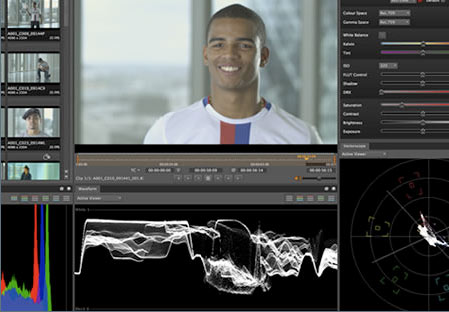The latest version of The Foundry's RED workflow beta, a kind of REDCineX "on steroids," is a free download until March 1.


Though STORM may have initially borrowed several feature ideas from NUKE, it has more closely followed a course circumnavigated by the 4,000 beta users who have downloaded each successive version since December 1. “It really came from us hearing about the need of the people in the market to handle RAW footage in a much simpler way,” says Chris Steele. As more commercial and large-scale productions are being shot on RED-several RED shows are currently in production, including Alfonso Cuarà³n’s Gravity (2012), at England’s Pinewood Studios, for example-The Foundry saw a grave need to streamline one too many convoluted workflows that had emerged amid the confusion. “We realized that users on RED productions were struggling with readily available tools, especially when it came time to prepare their media for editorial, effects and grading,” he says. “STORM’s just a straightforward and consistent way of handling your RED media in production, from the moment it comes off the camera, right through post-production on out to delivery. You can immediately check that what you’ve got is what you need on a granular level, review it, hit your select, prepare and assemble it-all before you pass it on to the edit. The R3D data is available to the enduser at all times throughout this process.”

Using STORM’s grading tools, you can toggle between shot look, RMD look and the user defined look
So far, say Steele and Paul Bickel, the comments from users have been overwhelmingly positive and have come in from those involved not just in film but in commercial, documentary, and a range of broadcast production. “The beta users we’re getting feedback from range from DITs to DoPs to colorists and editors,” says Bickel, “and they confirmed our original thinking that the workflows for RED were pretty jumbled and there was a head-numbing amount of options you could pursue in getting your files from your camera out to post.” Adds Steele, “We’ve had so much detailed feedback that it’s been very productive for us. Most are just simply pleased with how easy STORM is to use and how quickly they could adopt it. They’ve found the user interface quite logical and easy to understand and can start manipulating their media immediately. Other comments have to do with how well it supports Final Cut Pro workflows. Of course, many also want us to support other editorial workflows, which we’ll certainly be doing in the future.” Steele says they also have plans to support additional camera formats, though no decisions have been made about which ones will be next, and when support will be added.
The user interface, which now includes a multitrack timeline, was built to appeal to any number of users on set, “whether the director or production assistant or any number of editorial assistants,” says Steele. “All of them are really excited about the effects you can do based on the GPU,” says product designer James Wilson. “You can do lift, gamma and gain or very basic real-time color correction, say if you want to play around with saturations or desaturations and preview what it will look like in real time. That’s the basic performance you’ll get on a MacBook Pro, as well, so it’s pretty cool to have all that on your laptop. With the RED ROCKET card installed, you could be playing back in real time at 4K. With the new multitrack timeline in the latest version,” he adds, “you can conform a Final Cut Pro XML with any number of video tracks and any number of audio tracks inside the timeline.”
This video tutorial by Antler Post’s Nick Shaw from The Foundry’s Vimeo channel walks you through most of the basic features:
The STORM beta can be downloaded from www.thefoundry.co.uk/storm and is free to use until March 1, 2011, when the commercial version will be available for sale for $375 or £250.
Sections: Business Technology
Topics: Feature final cut pro
Did you enjoy this article? Sign up to receive the StudioDaily Fix eletter containing the latest stories, including news, videos, interviews, reviews and more.